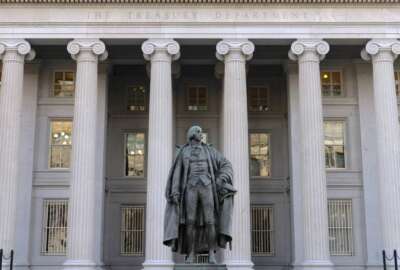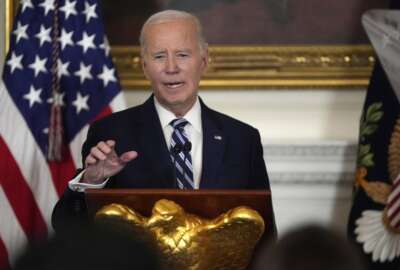Correction: AP Explains-Trump-National Monuments story
Correction: AP Explains-Trump-National Monuments story
In an April 26 story about the review of national monuments, The Associated Press reported erroneously the year the Antiquities Act was passed. It was enacted in 1906, not 1908.
A corrected version of the story is below:
AP Explains: Trump order sets up legal clash over vast lands
President Donald Trump’s order for the government to review national monuments created by three of his predecessors sets up a legal showdown over whether one chief executive has the power to undo another’s decisions
By JOHN FLESHER
AP Environmental Writer
President Donald Trump’s order for the government to review national monuments created by several of his predecessors sets up a legal showdown over whether one chief executive has the power to undo another’s decisions. At stake are federal lands revered for their natural beauty and historical significance.
The review goes well beyond a few declarations made in the waning months of Barack Obama’s term. It covers 24 monuments established by three former presidents over more than two decades. A closer look at the issues:
___
WHAT IS A NATIONAL MONUMENT?
The 1906 Antiquities Act, enacted under President Theodore Roosevelt, empowers the president to declare as national monuments any landmarks, structures and other “objects of historic or scientific interest” on land owned or controlled by the federal government. Roosevelt established 18 monuments, including the Grand Canyon in Arizona and Devil’s Tower in Wyoming. Most presidents since then have designated additional monuments. Congress has created others.
Most monuments are overseen by the National Park Service. Some are cared for by the federal Bureau of Land Management, the Fish and Wildlife Service or the Forest Service. Each agency has policies for protecting the land while also allowing some public use. For instance, some policies include limits on mining, timber cutting and recreational activities such as riding off-road vehicles.
___
A CONTENTIOUS HISTORY
Many national monument proclamations have enjoyed broad support. Others have been fiercely contested in Congress and the courts, including designations by Franklin D. Roosevelt (Jackson Hole National Monument, now Grand Teton National Park); Jimmy Carter (vast lands in Alaska); and George W. Bush (Papahanaumokuakea Marine National Monument northwest of Hawaii).
Trump’s choice of Jan. 1, 1996, as the starting date for his review was prompted by lingering resentment among Utah conservatives of Bill Clinton’s designation of the Grand Staircase-Escalante National Monument that year.
Critics say presidents increasingly are protecting areas that are too large and do not fit the law’s original purpose of shielding particular historical or archaeological sites. Designating millions of acres for scientific observation or sheltering rare species, they contend, is a “federal land grab” that ignores the wishes of local residents, although the lands already belonged to the government or were under federal control.
Interior Secretary Ryan Zinke says the pendulum has swung too far toward protecting public lands and away from the “multiple-use” concept advanced by Gifford Pinchot, the first chief of the Forest Service and an early leader in the conservation movement.
Supporters say the designations are essential to protect sensitive areas from looting and damage. Complaints about people getting kicked off the land are exaggerated, they say, and opposition fades as nearby communities benefit from tourism the monuments attract. A 2014 study by the nonprofit research group Headwaters Economics found that indicators such as employment, population and per-capita income held steady or improved in sections of the West where monuments larger than 10,000 acres had been established since 1981.
___
LEGAL PRINCIPLES
Some monuments have been reduced in size over the years, either by presidential order or by Congress, while others have been enlarged. But no president has tried to eliminate a predecessor’s monument. If Trump does so, his move will almost certainly be challenged in court.
The Antiquities Act does not explicitly say whether a president can nullify a monument proclamation. A legal analysis commissioned by the National Parks Conservation Association says no, pointing to a 1938 opinion by then-Attorney General Homer Cummings that a monument designation has the force of law and can be reversed only by Congress. A House report accompanying the Federal Land Policy and Management Act of 1976 agrees.
But a study for the conservative American Enterprise Institute released in March argues that when Congress authorizes the executive branch to write regulations, the power to repeal them generally can be assumed. That’s especially so, it says, when a president is correcting a predecessor’s act that exceeded what a law intended — such as creating vast monuments when the Antiquities Act says they should consist of “the smallest area compatible with the proper care and management of the objects to be protected.”
___
WHAT’S NEXT?
Trump’s order directs Zinke to review monument designations involving 100,000 acres or more. The interior secretary will submit an interim report within 45 days focusing on the Bears Ears National Monument in Utah, which Obama established last year. A final report is due in 120 days.
Zinke says the report will recommend whether any monuments should be abolished or resized. He promises an open-minded approach and says he remains opposed to selling any federal land or transferring it to state or local control.
Congress might weigh in as well. Numerous bills on the issue were introduced in the previous session, including measures to prevent the president from establishing or expanding monuments in particular states and to require consent of Congress or state legislatures.
Copyright © 2025 Federal News Network. All rights reserved. This website is not intended for users located within the European Economic Area.





